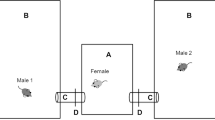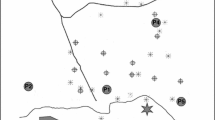Abstract
Some non-human animals may possess the ability to recall the “what”, “where”, and “when” of a single past event. We tested the hypothesis that male meadow voles posses the capacity to recall the “what”, “where”, and “when” of a single past event associated with mate selection in two experiments. Briefly, male voles were allowed to explore an apparatus that contained two chambers. One chamber contained a day-20 pregnant female (24 h prepartum). The other chamber contained a sexually mature female that was neither pregnant nor lactating (REF female). Twenty-four hour after the exposure, the males were placed in the same apparatus, which was empty and clean. At this time, the pregnant female would have entered postpartum estrus (PPE), a period of heightened sexual receptivity. Males initially chose and spent significantly more time investigating the chamber that originally housed the pregnant female (now a PPE female) than the chamber that originally housed the REF female. Male voles also explored an apparatus containing a chamber with a PPE female and one chamber containing a REF female. Twenty-four hour later, males were placed into an empty and clean apparatus. The males did not display an initial choice and they spent similar amounts of time investigating the chamber that originally housed the PPE female (now a lactating female) and the chamber that originally housed the REF female. The results of these and additional experiments suggest that male voles may have the capacity to recall the “what”, “where”, and “when” of a single past event, which may allow males to remember the location of females who would currently be in heightened states of sexual receptivity.






Similar content being viewed by others
References
Babb SJ, Crystal JD (2005) Demonstration of what, when, and where: implications for episodic-like memory in rats. Learn Motiv 36:177–189
Baddeley A, Conway M, Aggleton J (eds) (2001) Episodic memory: new directions in research. Oxford University Press, Oxford
Boonstra R, Xia X, Pavone L (1993) Mating system of the meadow vole, Microtus pennsylvanicus. Behav Ecol 4:83–89
Bronson FH (1989) Mammalian reproductive biology. University of Chicago Press, Chicago
Busby J, Suddendorf T (2005) Recalling yesterday and predicting tomorrow. Cogn Dev 20:362–372
Clayton NS, Dickinson A (1998) Episodic-like memory during cache recovery by scrub jays. Nature 395:272–274
Clayton NS, Griffiths DP, Emery NJ, Dickinson A (2001) Elements of episodic-like memory in animals. Philos Trans R Soc Lond B 356:1483–1491
Clayton NS, Bussey TJ, Dickinson A (2003) Can animals recall the past and plan for the future? Nat Rev Neurosci 4:685–691
Clayton NS, Emery NJ, Dickinson A (2006) The prospective cognition of food caching and recovery by western scrub jays (Aphelocoma californica). Comp Cogn Behav Rev 1:1–11
Dally JM, Emery NJ, Clayton NS (2006) Food-caching Western Scrub-Jays keep track of who was watching when. Science 312:1662–1665
delBarco-Trillo J, Ferkin MH (2004) Male mammals respond to a risk of sperm competition conveyed by odours of conspecific males. Nature 431:446–449
delBarco-Trillo J, Ferkin MH (2006) Male meadow voles respond differently to risk and intensity of sperm competition. Behav Ecol 17:581–585
delBarco-Trillo J, Ferkin MH (2007) Female meadow voles, Microtus pennsylvanicus, experience a reduction in copulatory behavior during postpartum estrus. Ethology (in press)
Dere E, Huston JP, De Souza Silva MA (2005) Episodic-like memory in mice: simultaneous assessment of object, place and temporal order memory. Brain Res Protocols 16:10–19
Dere E, Kart-Teke E, Huston JP, De Souza Silva MA (2006) The case for episodic memory in animals. Neurosci Biobehav Rev 30:1206–1224
Dewsbury DA (1990) Individual attributes generate contrasting degrees of sociality in voles. In: Tamarin RH, Ostfeld RS, Pugh SR, Bujalska G (eds) Social systems and population cycles in voles. Birkhauser Verlag, Basel, pp 1–9
Eacott MJ, Norman G (2004) Integrated memory for object, place, and context in rats: a possible model of episodic-like memory? J Neurosci 24:1948–1953
Eacott MJ, Easton A, Zinkivskay A (2005) Recollection in an episodic-like memory task in the rat. Learn Memory 12:221–223
Emery NJ, Clayton NS (2001) Effects of experience and social context on prospective caching strategies by scrub jays. Nature 414:443–446
Ergorul C, Eichenbaum H (2004) The hippocampus and memory for “what”, “where”, and “when.” Learn Memory 11:397–405
Ferkin MH (2006) The amount of time that a meadow vole, Microtus pennsylvanicus, self-grooms is affected by its reproductive state and that of the odor donor. Behav Processes 73:266–271
Ferkin MH, Johnston RE (1995) Effects of pregnancy, lactation, and postpartum oestrous on odour signals and the attraction in females meadow voles, Microtus pennsylvanicus. Anim Behav 49:1211–1217
Ferkin MH, Lee DN, Leonard ST (2004) The reproductive state of female voles affects their scent marking behavior and the responses of male conspecifics to such marks. Ethology 110:257–272
Franklin S, Ferkin MH (2006) An ontology for comparative cognition: a functional approach. Comp Cogn Behav Rev 1:36–52
Griffiths DP, Clayton NS (2001) Testing episodic memory in animals: a new approach. Physiol Behav 73:755–762
Griffiths DP, Dickinson A, Clayton NS (1999) Declarative and episodic memory: what can animals remember about their past? Trends Cogn Sci 3:74–80
Hampton RR, Schwartz BL (2004) Episodic memory in humans, what and where, is when? Curr Opinions Neurobiol 14:192–197
Hampton RR, Hampstead BM, Murray EA (2005) Rhesus monkeys (Macca mulatta) demonstrate robust memory for what and where but not when in an open-field test of memory. Learn Motiv 36:245–259
Huck M, Lottker P, Heymann EW (2004) Proximate mechanisms of reproductive monopolization in male moustached tamarins (Saguinus mystax). Am J Primatol 64:39–56
Keller BL (1985) Reproductive patterns. In: Tamarin RH (ed) Biology of New World Microtus. Special Publication of the American Society of Mammalogists, Lawrence, pp 725–778
Madison DM (1980) An integrated view of the social biology of meadow voles, Microtus pennsylvanicus. Biol 62:20–33
Meek LR, Lee TM (1993) Prediction of fertility by mating latency and photoperiod in nulliparous and primiparous meadow voles (Microtus pennsylvanicus). J Reprod Fert 97:353–357
Menzel CR (1999) Unprompted recall and reporting of hidden objects by a chimpanzee (Pan troglodytes) after extended delays. J Comp Psych 113:213–217
Mercado E, Murray SO, Uyeyama RK, Pack AA, Herman LM (1998) Memory for recent actions in the bottle-nosed dolphin (Tursiops truncates): replication of arbitrary behaviors using an abstract rule. Anim Learn Behav 26:210–218
Milligan SR (1982) Induced ovulation in mammals. Oxford Rev Reprod 4:1–46
Morris RGM, Day M (2003) Places and flavours: one-trial paired associate learning as a model of episodic-like memory in the rat. Int Congr Series 1250:183–198
Mulcahy NJ, Call J (2006) Apes save tools for future use. Science 312:1038–1040
Nelson K (1992) Emergence of autobiographical memory at age 4. Hum Dev 35:172–177
Roberts WA (2002) Are animals stuck in time? Psych Bull 128:473–489
Schwartz BL, Evans S (2001) Episodic memory in primates. Am J Primat 55:71–85
Schwartz BL, Hoffman M, Evans S (2005) Episodic-like memory in a gorilla: a review and new findings. Learn Motiv 36:224–226
Suddendorf T, Busby J (2003) Mental time travel in animals? Trends Cogn Sci 7:391–396
Suddendorf T, Corballis MC (1997) Mental time travel and the evolution of the human mind. Genet Soc Gen Psychol Monogr 123:133–167
Tulving E (1972) Episodic and semantic memory. In: Tulving E, Donaldson W (eds) Organization of memory. Academic, New York, pp 381–403
Tulving E (1983) Elements of episodic memory. Clarendon Press, Oxford
Tulving E (2001) Episodic memory and common sense: how far apart? Philos Trans R Soc Lond B 356:1505–1515
Tulving E (2002) Episodic memory: from mind to brain. Ann Rev Psych 53:1–25
Tzschentke TM (1998) Measuring reward with the conditioned place preference paradigm: a comprehensive review of drug effects, recent progress and new issues. Progr Neurobiol 56:613–672
Zentall TR, Clement TS, Bhatt RS, Allen J (2001) Episodic-like memory in pigeons. Psychonomic Bull Rev 8:685–690
Acknowledgments
We thank L. LaDage for reading this manuscript and three anonymous reviewers for their comments. This work was supported by National Science Foundation grant IOB 0444553, a National Science Foundation UMEB grant and NIH grant HD049525 to M. H. Ferkin. The experimental protocols were approved by The University of Memphis IACUC committee, which comply with the current laws of the United States.
Author information
Authors and Affiliations
Corresponding author
Rights and permissions
About this article
Cite this article
Ferkin, M.H., Combs, A., delBarco-Trillo, J. et al. Meadow voles, Microtus pennsylvanicus, have the capacity to recall the “what”, “where”, and “when” of a single past event. Anim Cogn 11, 147–159 (2008). https://doi.org/10.1007/s10071-007-0101-8
Received:
Revised:
Accepted:
Published:
Issue Date:
DOI: https://doi.org/10.1007/s10071-007-0101-8




